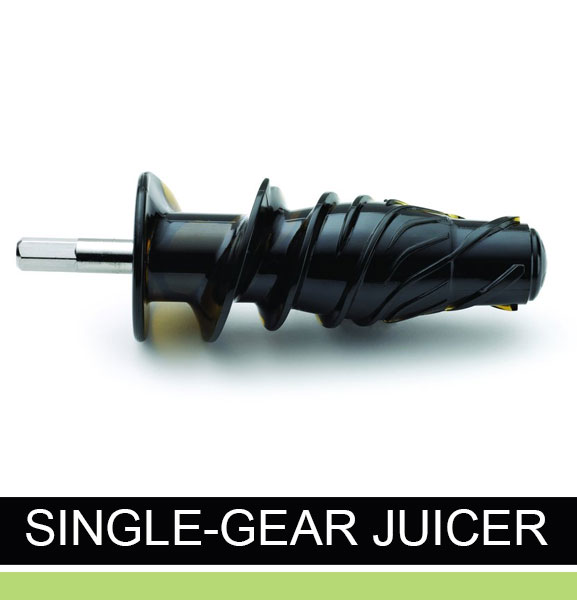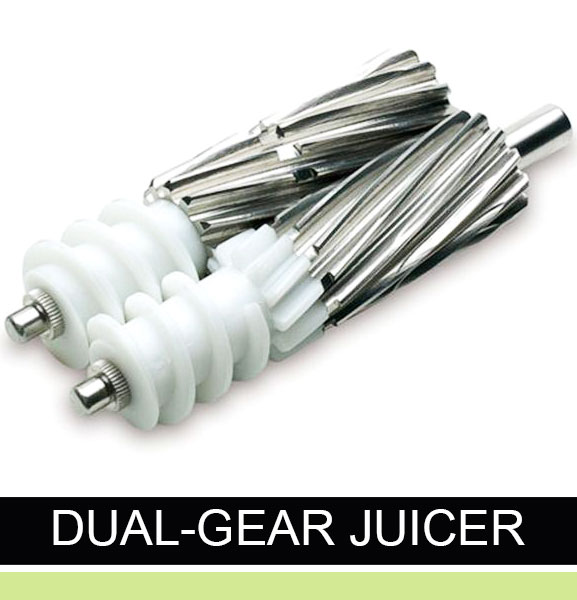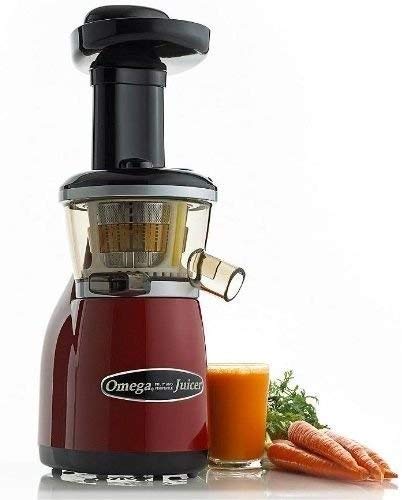Guide: Masticating Juicers (AKA: Single Gear / Slow Juicers / Cold-Press Juicers)
Last updated on
Masticating juicers, also known as single-gear, slow juicers, or cold-press juicers, are the “do-it-all” juicers. Manual juicers and centrifugal juicers are very popular, and while masticating juicers are less common, they are held to a higher standard in the juicing world.
They extract the maximum nutritional benefit from whatever fruits and vegetables you use and can handle leafy greens and hard greens as well. As an added bonus, many masticating juicers come with the ability to do more than just juice, making them a hand kitchen appliance for tasks like making homemade pasta or nut butter.
Advantages of Masticating Juicers
Better Juice
By keeping the speeds low and crushing, chewing, pressing your produce for all it’s worth, masticating juicers extract the most juice possible. The juice that results also is richer in enzymes and nutrients, and the pulp that results is very often dry and easily compostable or re-useable in other recipes
Low Noise
As the auger spins very slowly in the sub-100 RPM range compared to the multiple thousand RPM range of a centrifugal juicer, there is often little to no noise outside of the dripping of juice and the low hum of a strong motor turning the auger.
Juicing Ability & Power
Want to juice a lemon? It’ll do it. Want to throw some lemongrass or bits of sugar cane in there? It’ll do it. Want to extract spinach, wheatgrass, or kale juice? It’ll…. Well, you get the point.
Another advantage is that you can juice more than one thing at a time. Say you want some pineapple-kale juice. Simply prep the pineapple and kale, drop them in together, and they will both be juiced at the same time.
Longer-lasting Juice
As the enzymes and nutrients that stabilize fruits against spoiling and decay are preserved, the resulting juice can last up to 3 to 4 days in the fridge. Great for doing a large juicing session, and then having cold, fresh juice for your next few breakfasts.
Better Durability & Lifespan
Due to the price range and the powerful augers these juicers have, they often come with 3-year warranties as standard, with some of the higher end juicers having 10-year or greater warranties.
As well, by the action that it extracts juice, the only parts that truly experience wear are the auger itself and the motor, and often they are covered in the warranty as long as the juicer is used according to manufacturer directions
Disadvantages of Masticating Juicers
Expensive
The least expensive masticating juicers start at the $200 to $300 range and the most expensive triturating dual auger juicers capable of being well over $1000. The cost of masticating juicers alone means most people who buy them are committed to juicing.
Slow Juicing
By design, a masticating juicer will produce more juice compared to a centrifugal or manual juicer, however, it will do so at a much slower rate due to the speed that the auger turns. Whereas a centrifugal juicer might be able to produce 500 mL of juice in under a minute, a masticating juicer would take quite a few minutes to match that output.
Smaller Feed Chute
The auger in a masticating juicer is enclosed and does not have a wide area to spin and produce meets the auger directly instead of first being sliced or grated, meaning only smaller chunks of produce will fit. Smaller chunks means more time spent chopping before you start juicing.
What Should I Look for in a Masticating Juicer?
A masticating juicer has four major points to keep an eye out for:
- Single vs dual auger
- Speed and power
- Ease of maintenance
- Size and intended use
Single vs Dual Gear
Rather than spinning pulp at high speed against an extraction filter, masticating juicers quite literally “chew” the produce you put into them. This happens via the use of a single gear, or dual gear turning against each other.
An easy way to visualize a gear or auger is to imagine a drill. At one end, you have the point, at the other, the shaft, and along the way there are two edges in a spiral that grab and cut whatever it is you are drilling into. The way a gear in a juicer differs is that it is in a tightly fitting tube, with a filter mesh surrounding that tube, and many holes and slots near the end of the auger for pulp to exit.
A single gear is most commonly found at the lower end of the budget range for masticating juicers and commonly does not last nearly as long as a dual-gear type juicer. However, a single-gear juicer will still process everything from beets to pineapples, spinach to wheatgrass, and all things in between.
A dual-gear juicer, which can also be called a triturating juicer, is often in the mid to high end of the budget range, as it is more complex but also exponentially more powerful and can endure even the hardest of fruits and vegetables.
Speed & Power
While speed is not nearly as important in a masticating juicer as it is in a centrifugal one, there are masticating juicers that do have selectable speeds. The fastest a masticating juicer will turn is usually in the 80 to 100 RPM range, however, this is still fast enough for some tougher fruits and vegetables to cause heat inside the auger, and promote the breakdown of nutrients and enzymes.
As well, higher speeds don’t extract the most out of leafy greens and grasses, which work best with very low speeds, down to about 40-60 RPM. A multi-speed masticating juicer is highly recommended.
Power is the key to a masticating juicer, but not in terms of generating speed. What you want to look for in a masticating juicer is high torque, which is the power that can be generated to spin the auger. The more torque, the harder the type of fruits and vegetables you can use with less prep time.
Ease of Maintenance
A masticating juicer is, by the very nature of its design, much more time consuming to maintain, however with good reason. There are far more parts involved in the extraction of the juice, and many of them are within assemblies within the full unit, such as the auger tube, the auger itself, and the filter. As well, some models have auger tubes that are hard-fixed inside the unit, however, these units will often have a multi-speed mode that includes an “R” setting, for reverse, so it will back out the pulp and debris that remains after juicing.
Size and Intended Use
Masticating juicers can vary in size from a small juicer that fits neatly into a cupboard, to a full countertop unit that can rival crock pots and toaster ovens inside and space needed. The best size to use depends on the intended use. If you are going to be juicing every day, twice a day, then a full countertop unit will make things much easier to access, set up, clean, and juice with. If the intention is to extract juice every few days, then a smaller unit that can be cleaned and placed out of the way when not in use would be more beneficial.
Our Top Recommendations for Masticating Juicers
We have 2 favorites for you: a vertical option and a horizontal option.
Omega VRT 330
As a vertical masticating juicer, the Omega VRT 330 saves space on your countertop without compromising on juicing efficiency. It’s easy to use, quiet, and best of all, it won’t cost you an arm and a leg. Read our full review of the Omega VRT 330 here.
Get Yours on Amazon
When you make a purchase via one of our affiliate links, we may earn a small commission. We buy all the ingredients and juicers for our reviews and recipe posts and rely on this revenue to maintain our website. Thank you for supporting us 🙂
Omega NC900HDC
The Omega NC900HDC is a bit pricier than its vertical counterpart, but you won’t be disappointed with this horizontal masticating juicer. This juicer also works as a pasta maker, sorbet maker, and overall food processor, making it well worth the investment. And in addition to the numerous applications and features, it’s also quiet and easy to clean. Read our full review of the Omega NC900HDC here.
Get Yours on Amazon
When you make a purchase via one of our affiliate links, we may earn a small commission. We buy all the ingredients and juicers for our reviews and recipe posts and rely on this revenue to maintain our website. Thank you for supporting us 🙂
Some of the links I post on this site are affiliate links. If you go through them to make a purchase, I will earn a small commission (at no additional cost to you). However, note that I’m recommending these products because of their quality and that I have good experience using them, not because of the commission to be made.



































 JOIN OVER
JOIN OVER